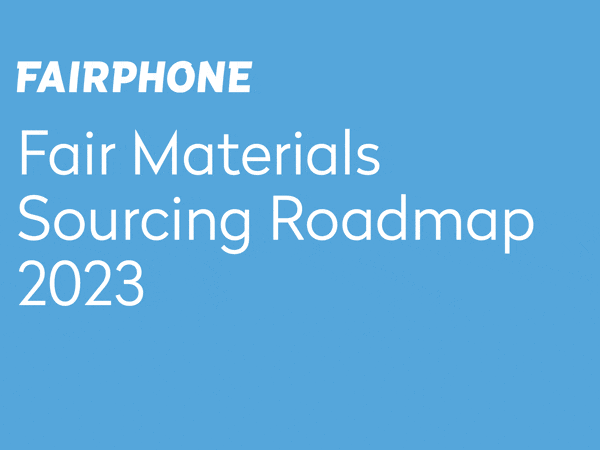
Lessons in sustainable supply chain management: what consumer electronics can learn from the Fairphone approach

I was invited to speak alongside other experts at the launch of Fairphone’s ‘Fair Materials Sourcing Roadmap 2023’. The creation of this roadmap has been a lengthy and complex process. But this plan of action gives Fairphone the ability to demonstrate publicly how it is addressing sustainable supply chain management sourcing. We are proud to have played a part in its creation.
It examines each touchpoint of the material supply chain, from mining, design and manufacture, to waste recovery and recycling. It helps us understand the materials, people and practices at each point. Fairphone can now begin to identify where and how it can push further towards producing a sustainable product.
This roadmap was specifically designed for Fairphone, but there are lessons for the consumer electronics industry and beyond.
Your role in sustainable supply chain management
There are so many questions around how we go about creating more sustainable supply chains, not least where the responsibility lies. Whose business is it?
Is it a business’s responsibility? Do we have the influence to do anything? If it is our responsibility, what can and should we do?
Businesses across all sectors will have legal or regulatory obligations to meet in their sustainable supply chain management. They will face pressure from investors, need to have security of supply and many will strive to meet voluntary standards. But will the corporate world recognise a moral obligation? More importantly, will its customers?
Corporate reputation can be both the carrot and the stick driving the sustainability agenda in business. Those that fail to act risk rebellion from the media and consumers. And those who act above and beyond their obligations and can demonstrate measurable outcomes stand to gain advocacy and acclaim.
Prioritise – you can’t tackle everything at once
Fairphone recognised that they could not address all the concerns associated with sustainable supply chain management at once. So they focused on a shortlist of opportunities. This provided a starting point to identify the most significant issues and facilitated a good general knowledge of their supply chain.
We have been working with Fairphone since 2017, when we helped them develop a strategy that matched their ambitions and corporate culture. This approach was adopted again to prioritise the materials for the 2023 Roadmap. The first stage was to analyse 38 of the materials in a smartphone using a specific set of criteria.
The criteria allowed Fairphone to prioritise issues, geographies, metals and industry segments. Essential as part of sustainable supply chain management. It also meant they could identify opportunities for intervention. With their recent announcement of the 2023 sourcing roadmap, Fairphone shortlisted 14 materials to focus on.
Don’t demonise cobalt (or any other material)
The use of some materials come with significant reputational risk. Cobalt is a prime example – it’s the metal we all love to hate. It’s a material so ubiquitous in our everyday lives. We find cobalt in our devices, our tools, our cars, jewellery, cosmetics, and even some foods. Yet it is considered a high-risk mineral.
How does it fit into sustainable supply chain management?
Cobalt is mined in the Democratic Republic of Congo (DRC). DRC is rich in minerals and natural resources but plagued by violence, inequality, child labour, poor human rights.
One strategy is to replace cobalt where they can, to drive materials recovery and recycling. This reduces reliance and the level of risk in their own supply chain. Yet this doesn’t solve the problem, it simply avoids it. The result? Falling income for the miners and falling standards of living in their communities.
The problem is not the material. It is the way in which it is produced. And if brands can recognise this and make impact part of their strategy. we will be truly driving sustainable practices and business, to the benefit of all. Fairphone is already doing this through a number of initiatives to support mining communities in the DRC.
An important step that Fairphone has made to address this is joining us in the founding of the Fair Cobalt Alliance (FCA). The FCA strives to drive the development of fair cobalt by supporting the professionalisation of artisanal and small-scale mining. The goal is to make mines safer, to minimise environmental impact and create decent working conditions for people who work there.
Have a long-term ambition, but realistic short-term goals
Longer lasting products, end of life disposal and takeback and recycling programmes – all long-term ambitions for sustainable supply chain management. This idea of the circular economy, with little reliance on the extraction of new materials is the panacea. But the reality is far more complex. Not all materials can be recovered and there are challenges within the recycling sector around capability, availability and cost.
With global population growth and economic development fuelling demand for devices, our appetite for many of the materials used will outpace the industry’s ability to meet the need through recycling.
This means mining will remain part of the process for years to come.
So, while sustainable sourcing and production remain the end goal, we need to zoom in on the here and now, with practical and realistic goals in the short term. The end goal is sustainable supply chain management.
Material impact is more than risk mitigation
We must draw a distinction between risk mitigation and material impact. The former sees business identifying areas of the supply chain that pose a risk to the business, to reputation, to production capacity, to compliance. The risk is removed through diversion or avoidance. The latter also refers to addressing the root cause of the issues and identifying opportunities for positive change.
This is where a business can alter the lives and livelihoods of communities in the supply chain for the better. We need material impact to meet the hopes and expectations of company stakeholders and drive positive reputation. In short, material impact is good for business.
In addition to mapping and ranking raw materials by ‘risk’ and ‘impact’, businesses can identify the initiatives and projects that they could join. This can make a significant difference in improving operating practices. It is an area that we are supporting Fairphone to scale and implement.
With multiple, complex material supply chains, consumer electronics firms cannot (and should not) attempt to identify and address all concerns at once. To help businesses and the lives of communities touched by the making of smartphones, we need to focus and leadership; the ability to test and learn, to build and evolve a robust sustainability framework.
This is critical if we want sustainable supply chain management.